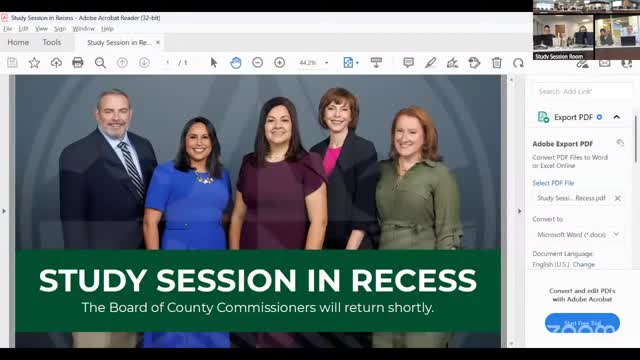Adams County Proposes New Zoning Standards for Parking and Landscaping Improvements
September 23, 2025 | Adams County, Colorado
This article was created by AI summarizing key points discussed. AI makes mistakes, so for full details and context, please refer to the video of the full meeting. Please report any errors so we can fix them. Report an error »

During the September 23, 2025, Board of County Commissioners Study Session in Adams County, Colorado, officials discussed significant updates to zoning regulations aimed at modernizing parking standards and enhancing community mobility. The meeting highlighted a shift from traditional minimum parking requirements to a more flexible maximum parking cap, reflecting evolving societal needs and technological advancements.
One of the key proposals involves implementing a maximum parking requirement set at 150% of the minimum needed for various land uses. This change aims to prevent over-parking, which has become a common issue in many communities. For instance, if a commercial space requires 20 parking spaces, the maximum allowed would be 30. This approach is designed to accommodate larger buildings differently, allowing for reduced parking ratios as building sizes increase, thereby minimizing the footprint of parking lots.
The discussion also touched on the inclusion of provisions for bicycle parking and electric vehicle charging stations, emphasizing a commitment to sustainable transportation options. Developers would be required to provide at least one bicycle parking space, with additional spaces mandated based on the number of vehicle parking spots. Similarly, larger developments would need to include electric vehicle charging stations, ensuring that infrastructure keeps pace with the growing demand for eco-friendly transportation.
In addition to parking, the meeting addressed enhancements to landscaping and pedestrian circulation. Officials proposed clearer guidelines for buffer yards—landscaped areas that separate conflicting land uses—and designated pedestrian pathways to improve safety and accessibility. These updates aim to create a more organized and visually appealing environment, aligning with national best practices.
The conversation also acknowledged the impact of recent state legislation on multifamily housing, which may exempt certain developments from parking requirements if they are located within designated transit corridors. This aspect of the discussion underscores the county's efforts to adapt to changing housing dynamics and promote transit-oriented development.
Overall, the meeting underscored a proactive approach to zoning that prioritizes community needs, sustainability, and modern urban planning principles. As these proposals move forward, they are expected to significantly influence the development landscape in Adams County, fostering a more integrated and accessible community for residents.
One of the key proposals involves implementing a maximum parking requirement set at 150% of the minimum needed for various land uses. This change aims to prevent over-parking, which has become a common issue in many communities. For instance, if a commercial space requires 20 parking spaces, the maximum allowed would be 30. This approach is designed to accommodate larger buildings differently, allowing for reduced parking ratios as building sizes increase, thereby minimizing the footprint of parking lots.
The discussion also touched on the inclusion of provisions for bicycle parking and electric vehicle charging stations, emphasizing a commitment to sustainable transportation options. Developers would be required to provide at least one bicycle parking space, with additional spaces mandated based on the number of vehicle parking spots. Similarly, larger developments would need to include electric vehicle charging stations, ensuring that infrastructure keeps pace with the growing demand for eco-friendly transportation.
In addition to parking, the meeting addressed enhancements to landscaping and pedestrian circulation. Officials proposed clearer guidelines for buffer yards—landscaped areas that separate conflicting land uses—and designated pedestrian pathways to improve safety and accessibility. These updates aim to create a more organized and visually appealing environment, aligning with national best practices.
The conversation also acknowledged the impact of recent state legislation on multifamily housing, which may exempt certain developments from parking requirements if they are located within designated transit corridors. This aspect of the discussion underscores the county's efforts to adapt to changing housing dynamics and promote transit-oriented development.
Overall, the meeting underscored a proactive approach to zoning that prioritizes community needs, sustainability, and modern urban planning principles. As these proposals move forward, they are expected to significantly influence the development landscape in Adams County, fostering a more integrated and accessible community for residents.
View full meeting
This article is based on a recent meeting—watch the full video and explore the complete transcript for deeper insights into the discussion.
View full meeting
